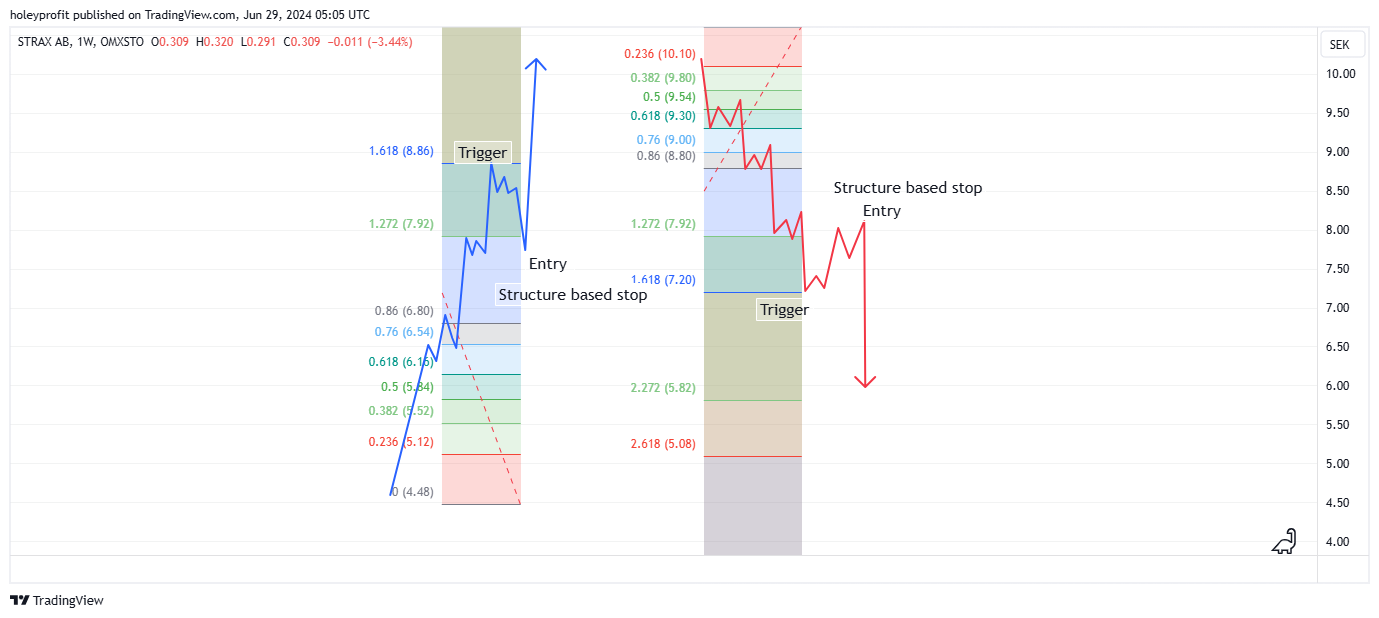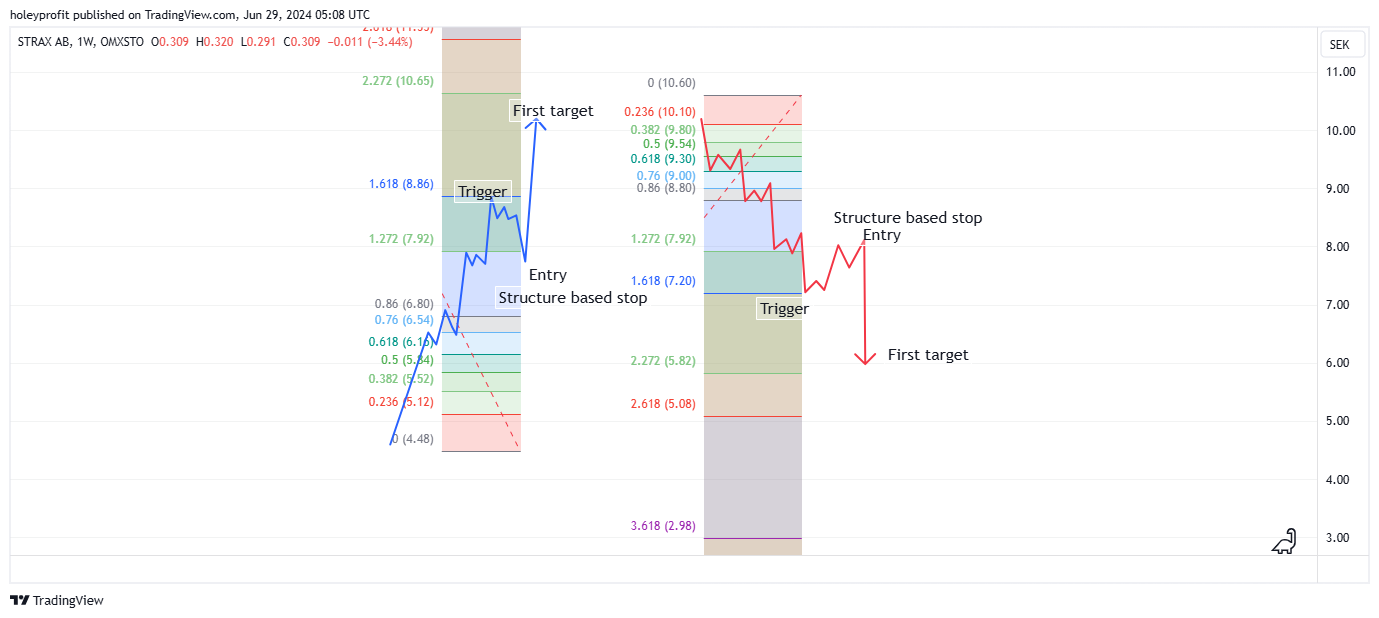1.27 Retest and Continuation Strategy
Trend continuation
This is part of a series of strategy posts.
Once all strategy posts are up, they will be linked together. Initially there will be placeholders for links - Marked “(Link)”. This is because all posts need to be published to be able to interlink them. Please check back later for complete interlinking.
The original series of posts will contain 15 strategies. All of them time tested and ones I’ve personally used to make a living in markets for over 10 years. These will all be free. Multiple additional posts will be added for paid members. Discussing advanced strategy, nuances and covering the common questions we’d expect about the strats.
You can join as a paid member for only $15.
Strategy Name:
-1.27 Retest and Continuation Strategy
Strategy Type:
-Trend continuation
Strategy Premise Overview:
-At the core, this is a simple breakout and continuation strategy with additional rules to define entry and exit criteria more precisely. It is based on the premise that a breakout price will often extend to a 1.27 of the previous pullback before retesting the breakout.
-The strategy aims to trade a breakout and retest for entry, using Fibonacci rules for stops and targets.
Planning Entries:
- This strategy starts where the 76 Failure Strategy ends. When there’s been a 76/86 break out and this has went onto hit the 1.27 extension.
- In this trade setup we’re making another correction and continuation bet.
- This strategy is very similar to the 1.27 Continuation Strategy. We’re looking for the same general move but instead of a bounce on 1.27 we look for it on 1.61.
-The target move is a correction somewhere near the 1.61 fib and then the 1.27 fib holding a retesting for a continuation.
-Set an alert at the 1.61 Fibonacci extension level. The breakout should align with a slight breakout of the last high or low.
-If the breakout does not align, revaluate the validity of the Fibonacci levels.
-When the 1.61 Fibonacci extension level is hit, it signals a breakout. Note: Placing the alert a bit past the 1.61 so it has to have actually broken can filter out some losing signals (But will filter out some winners too, nothing is free in trading).
-Place a pending limit order at the 1.27 Fibonacci extension level for a retest of the breakout.
-Ideal outcome.
Planning Stops:
-We can define our max stop on this using the broken retracement fibs. We should break the 76/86. Break the 1.27 and retest the 1.27. Our widest stop goes behind the 86% or 76% fibs. Note, these are wide stops and are where I’d consider the setup to have entirely failed.
- Most commonly I’ll be using tight stops here based on structure and price action and they’ll be coming in only a little past the 1.27. In this setup I have a tolerance for only only small spike outs of the 1.27.
Planning Targets:
-The initial target is near the 2.20 Fibonacci extension level.
-The main concern when this trade is working is we’re going to run into a 2.20 pullback to 1.27. Which would eat all the running profit.
- These can be very quick moves. Crashing against if you’re long and inverse crashing against you if you’re short. These are sometimes setting up larger continuation trades but in these setups it’s best to bank profits and plan re-entry.
-Following target is the 2,61 fib. This is another area there’s liable to be bigger pullbacks.
-Use trailing stops to manage the trade beyond the 2.20 level, locking in profits as the price moves higher. If 2.61 fails as a reversal level price can make an extremely strong move into the following fibs. This move can double the amount of profit on the trade.
Typical Win Path:
-Typically once the 86% level has failed there will be a strong move to 1.27.
-1.27 does not act as much of a pullback level. There can be some nominal near term reaction but we trade through to the 1.61.
-1.27 is usually retested after a false breakout of 1.61 and often takes two legs to retest.
-1.27 turns are fairly crisp and clean. There can be some ranges and head fakes but the move becomes consistent to at least close to the 2.20 fib after reversal.
Typical Lose Path:
- The major risk in this setup is you end up trading against one of the 1,61 reversal patterns. (Link
-In that type of setup, a major high or low will have been made. The trading that you thought was a breakout was a final stop run and you’re going to see a lot of momentum when the trend structure breaks.
Why Strategy is Expected to be Successful:
-The strategy leverages time-tested concepts of trend development and breakout-continuation trades.
-It provides a defined level to trigger a breakout, actionable target levels, tight stop management, and a clear roadmap for expected moves post-breakout.
-Using the tight stop method it consistently gives at least 1:2 RR to the 2.20 fib with the potential for major pay offs in the times it runs. 1:2 RR means the win rate needed to break even isn’t that high and you’d only be likely to miss it if you were not trading with a trend. In trending conditions this has high odds of breaking even with potential big pay offs.
Known Risks and Weaknesses:
-Big risk with this strategy is it bets against 1.61 reactions, and these can be major highs/lows.
-Tight stop loss rules are hard to define with exact repeatable rules since they are structure based. Done incorrectly, this can be a problem.
- Read more about the counter strategy for this failing here (Link).
Trade Plan Execution:
Bullish Execution Plan:
Step 1: Market Analysis
There are two ways to use this strategy:
Trend development.
Trend reversal .
If we’re looking for continuations, we keep drawing our retracement levels on the drops. High to low of the drops with the thesis if the new high will fail it should do so around 76% fib. If and when there’s a new high made, we then use this fibs set to place alerts on the 1.61 and plan the 1.27 trade.
If we’re trading a trend reversal we’ll have had a big move into a new high but then when the simple 76 Continuation levels fail this strategy can be used to plan out possible routes for a trend reversal.
Step 2: Draw Fibonacci Extensions
Draw the fibs and wait for the 86% fib to break.
When the 86 fib breaks, we can plan out where the next important levels are and plot possible trade paths.
Step 3: Set Alert
Set an alert at the 1.61 Fibonacci extension level.
When a new high has been made, set an alert on the 1.61 (Or past it if looking to filter for only 1.61 breaks).
Step 4: Confirmation and Entry
When the alert pings, it signals a breakout has occurred.
Place a pending limit order at the 1.27 Fibonacci extension level for the retest.
Step 5: Place Stop Loss
Set stop losses behind the 86% Fibonacci retracement level or based on market structure.
Alternatively, place a tighter stop loss just below the 61% Fibonacci retracement level.
Step 6: Manage Trade
Profits should be locked in as we get close to 2.20 fib since even in overall continuation patterns our entry can re-test.
2.61 is another big pullback risk area where stops should be trailed. If 2.61 breaks, trail stops behind new lows and run into the following fibs if it allows.
Step 7: Set Targets
The initial target is near the 2.20 Fibonacci extension level if trading this passively.
If managing by trailing stop set an alert close to 2.20 to inform you to trail stops.
Step 1: Market Analysis
There are two ways to use this strategy:
Trend Development:
Trend Reversal:
Trend Development:
If we’re looking for continuations, we keep drawing our retracement levels on the rises. Low to high of the rises with the thesis if the new low will fail it should do so around the 76% fib. If and when there’s a new low made, we then use this fibs set to place alerts on the 1.61 and plan the 1.27 trade.
Trend Reversal:
If we’re trading a trend reversal, we’ll have had a big move into a new low, but then when the simple 76 Continuation levels fail, this strategy can be used to plan out possible routes for a trend reversal.
Step 2: Draw Fibonacci Extensions
Draw the fibs and wait for the 86% fib to break.
When the 86 fib breaks, we can plan out where the next important levels are and plot possible trade paths.
Step 3: Set Alert
Set an alert at the 1.61 Fibonacci extension level.
When a new low has been made, set an alert on the 1.61 (or past it if looking to filter for only 1.61 breaks).
Step 4: Confirmation and Entry
When the alert pings, it signals a breakout has occurred.
Place a pending limit order at the 1.27 Fibonacci extension level for the retest.
Step 5: Place Stop Loss
Set stop losses above the 86% Fibonacci retracement level or based on market structure.
Alternatively, place a tighter stop loss just above the 61% Fibonacci retracement level.
Step 6: Manage Trade
Profits should be locked in as we get close to the 2.20 fib since even in overall continuation patterns our entry can re-test.
2.61 is another big pullback risk area where stops should be trailed. If 2.61 breaks, trail stops above new highs and run into the following fibs if it allows.
Step 7: Set Targets
The initial target is near the 2.20 Fibonacci extension level if trading this passively.
If managing by trailing stop, set an alert close to 2.20 to inform you to trail stops.

















